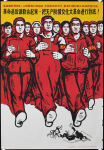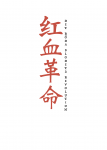En grej som inträffat flera gånger i efterforskningarna för den här kampanjen har varit att det finns något jag hört talas om, jag tänker "Det där var ju lite crazy", och sedan börjar jag läsa om det och liksom, "Vad i helvete, Kina?". Taiping-upproret var en sådan grej. Kulturrevolutionen är en annan. Jag visste liksom att det var en galen tid och att rödgardister gick runt och slog sönder tempel, typ. Sedan läser man lite:
(Varning för extrem brutalitet nedan)
Methods of slaughter during the Red August included beating, whipping, strangling, trampling, boiling, beheading and so on; in particular, the method used to kill most infants and children were knocking them against the ground or slicing them in halves.
On May 16, 1966, Cultural Revolution began in mainland, China. On August 5, Bian Zhongyun, the first vice principal of the Experimental High School Attached to Beijing Normal University, was beaten to death by Red Guards and was the first education worker in Beijing killed by the Red Guards.
(Notera "High School". Ledaren för gruppen var 17. Som tack blev hon hyllad av Mao, som beordrade polisen att inte arrestera några rödgardister utan låta dem hållas.)
The Cultural Revolution was characterized by violence and chaos. Death toll claims vary widely, with estimates of those perishing during the Revolution ranging from hundreds of thousands to millions. Beginning with the Red August of Beijing, massacres took place nationwide, including the Guangxi Massacre, in which massive cannibalism also occurred; the Inner Mongolia incident; the Guangdong Massacre; the Yunnan Massacres; and the Hunan Massacres.
Vad i helvete, Kina?
One of the mangoes was sent to the Beijing Textile Factory, whose revolutionary committee organised a rally in the mangoes' honour. Workers read out quotations from Mao and celebrated the gift. Altars were erected to display the fruit prominently; when the mango peel began to rot after a few days, the fruit was peeled and boiled in a pot of water. Workers then filed by and each was given a spoonful of mango water. The revolutionary committee also made a wax replica of the mango and displayed this as a centrepiece in the factory. There followed several months of "mango fever," as the fruit became a focus of a "boundless loyalty" campaign for Chairman Mao. More replica mangoes were created, and the replicas were sent on tour around Beijing and elsewhere in China. Many revolutionary committees visited the mangoes in Beijing from outlying provinces; approximately half a million people greeted the replicas when they arrived in Chengdu. Badges and wall posters featuring the mangoes and Mao were produced in the millions.
Vad i helvete, Kina?
Och sedan kommer man till Guangxi …
In certain areas including Wuxuan County and Wuming District, massive human cannibalism occurred even though no famine existed. According to public records available, at least 137 people—perhaps hundreds more—were eaten by others and at least thousands of people participated in the cannibalism. Other researchers have pointed out that 421 victims who could be identified by name were eaten, and there were reports of cannibalism across dozens of counties in Guangxi.
…
In 1968, 38 people in Wuxuan County were eaten, and 113 officials of the county participated in eating human flesh, hearts and livers. Chen Guorong (陈国荣), a peasant from Guigang County who happened to pass by Wuxuan, was caught and killed by local militia because he was fat; his heart and liver were taken out while his flesh was distributed to 20 people. A female militia leader ate 6 human livers in total, and cut the genitals of 5 men and soaked them in alcohol which she would drink later, claiming that these organs were beneficial to her health. The behavior of eating human flesh, hearts and livers occurred in many counties of Guangxi including Wuxuan, Wuming, Shangsi, Guigang, Qinzhou, Guiping, and Lingyun ... After the revolutionary committee was established in Shangsi County, a "killing conference" was held at Pingshan Square (平山广场) on September 1, 1968, during which more than 10 officials and civilians were beaten to death. After the conference, a committee member, Li Hao (黎郝), removed the hearts and livers from the corpses, sauteing them and preparing them as dishes for other representatives who attended the conference.
…
VAD I HELVETE, KINA?!?
(Varning för extrem brutalitet nedan)
Methods of slaughter during the Red August included beating, whipping, strangling, trampling, boiling, beheading and so on; in particular, the method used to kill most infants and children were knocking them against the ground or slicing them in halves.
On May 16, 1966, Cultural Revolution began in mainland, China. On August 5, Bian Zhongyun, the first vice principal of the Experimental High School Attached to Beijing Normal University, was beaten to death by Red Guards and was the first education worker in Beijing killed by the Red Guards.
(Notera "High School". Ledaren för gruppen var 17. Som tack blev hon hyllad av Mao, som beordrade polisen att inte arrestera några rödgardister utan låta dem hållas.)
The Cultural Revolution was characterized by violence and chaos. Death toll claims vary widely, with estimates of those perishing during the Revolution ranging from hundreds of thousands to millions. Beginning with the Red August of Beijing, massacres took place nationwide, including the Guangxi Massacre, in which massive cannibalism also occurred; the Inner Mongolia incident; the Guangdong Massacre; the Yunnan Massacres; and the Hunan Massacres.
Vad i helvete, Kina?
One of the mangoes was sent to the Beijing Textile Factory, whose revolutionary committee organised a rally in the mangoes' honour. Workers read out quotations from Mao and celebrated the gift. Altars were erected to display the fruit prominently; when the mango peel began to rot after a few days, the fruit was peeled and boiled in a pot of water. Workers then filed by and each was given a spoonful of mango water. The revolutionary committee also made a wax replica of the mango and displayed this as a centrepiece in the factory. There followed several months of "mango fever," as the fruit became a focus of a "boundless loyalty" campaign for Chairman Mao. More replica mangoes were created, and the replicas were sent on tour around Beijing and elsewhere in China. Many revolutionary committees visited the mangoes in Beijing from outlying provinces; approximately half a million people greeted the replicas when they arrived in Chengdu. Badges and wall posters featuring the mangoes and Mao were produced in the millions.
Vad i helvete, Kina?
Och sedan kommer man till Guangxi …
In certain areas including Wuxuan County and Wuming District, massive human cannibalism occurred even though no famine existed. According to public records available, at least 137 people—perhaps hundreds more—were eaten by others and at least thousands of people participated in the cannibalism. Other researchers have pointed out that 421 victims who could be identified by name were eaten, and there were reports of cannibalism across dozens of counties in Guangxi.
…
In 1968, 38 people in Wuxuan County were eaten, and 113 officials of the county participated in eating human flesh, hearts and livers. Chen Guorong (陈国荣), a peasant from Guigang County who happened to pass by Wuxuan, was caught and killed by local militia because he was fat; his heart and liver were taken out while his flesh was distributed to 20 people. A female militia leader ate 6 human livers in total, and cut the genitals of 5 men and soaked them in alcohol which she would drink later, claiming that these organs were beneficial to her health. The behavior of eating human flesh, hearts and livers occurred in many counties of Guangxi including Wuxuan, Wuming, Shangsi, Guigang, Qinzhou, Guiping, and Lingyun ... After the revolutionary committee was established in Shangsi County, a "killing conference" was held at Pingshan Square (平山广场) on September 1, 1968, during which more than 10 officials and civilians were beaten to death. After the conference, a committee member, Li Hao (黎郝), removed the hearts and livers from the corpses, sauteing them and preparing them as dishes for other representatives who attended the conference.
…
VAD I HELVETE, KINA?!?


 Gula blommans kulle är rätt våldsamt, men det är först i slutet. Det här scenariot kan bli våldsamt redan någonstans i mitten.
Gula blommans kulle är rätt våldsamt, men det är först i slutet. Det här scenariot kan bli våldsamt redan någonstans i mitten.
